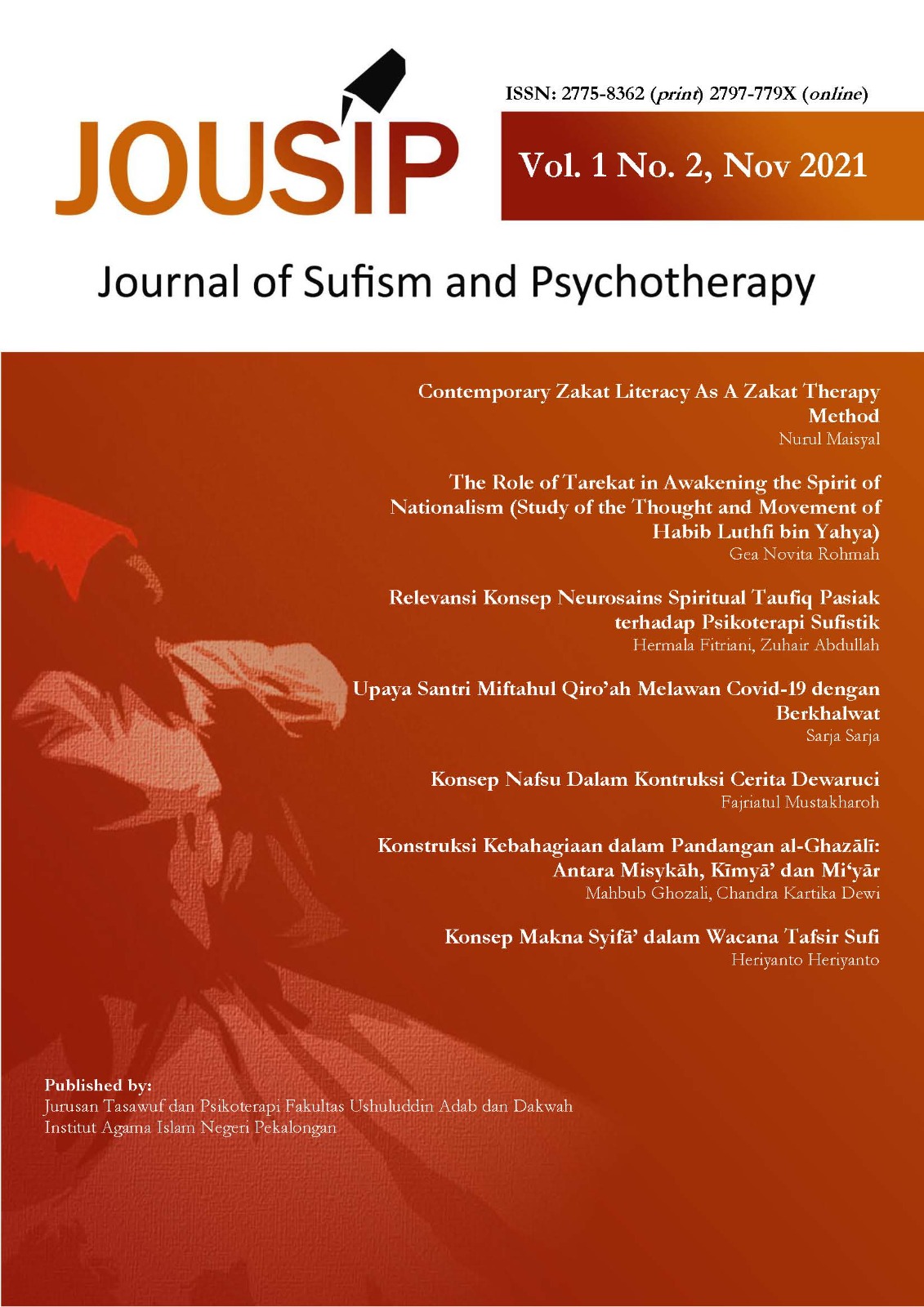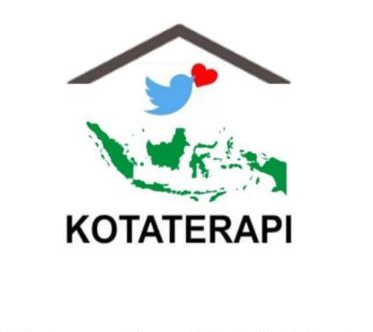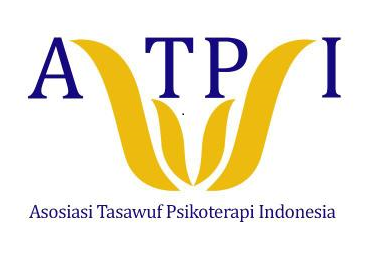Konstruksi Kebahagiaan dalam Pandangan al-Ghazālī: Antara Misykāh, Kīmyā’ dan Mi‘yār
DOI:
https://doi.org/10.28918/jousip.v1i2.4248Keywords:
al-Ghazālī, happiness, islamic sufismAbstract
The construction of happiness in al-Ghazālī’s view is unique than a concept of happiness in the other Sufism’s though which are more directed to the happiness of the hereafter. Al-Ghazālī gives the view that the happiness of the hereafter can only be achieved if the happiness of this world has been fulfilled. This study aims to find the process and transformation of happiness achieved in the world to form happiness in the hereafter. To achieve this goal, this study uses a qualitative method with a content analysis tool. This study shows that the achievement of happiness starts from the most basic structure, namely the body as a foothold (misykāh). The body with all its body parts doing what is beautiful actions and in accordance with sharia. Beautiful action and accordance with sharia will lead to happiness in the world. However, the actions of the body parts are controlled from within by the heart in synergy with the mind as the source of knowledge. The synergy of both of them maintain the stability of actions so that they do not deviate from the standards (mi’yār) that are determined until they are transformed into happiness in the hereafter with ma’rifah Allah (seeing the God).
References
Al-’Āmirī, M. G. (1426). al-Sa’ādah fī al-Manzūr al-Islāmī. Dār Ibn Ḥazm.
Al-Attas, M. N. (1970). The Mysticism of Hamzah Fansuri. University of Malaya Press.
Al-Ghazālī, A. H. M. bin M. (n.d.-a). Faḍā’iḥ al-Bāṭiniyah. Mu’assasah Dār al-Kutub al-Thaqāfiyah.
Al-Ghazālī, A. H. M. bin M. (n.d.-b). Iḥyā’ ’Ulūm al-Dīn (Vol. 3). Dār al-Ma’rifah.
Al-Ghazālī, A. H. M. bin M. (n.d.-c). Iḥyā’ ’Ulūm al-Dīn (Vol. 1). Dār al-Ma’rifah.
Al-Ghazālī, A. H. M. bin M. (n.d.-d). Iḥyā’ ’Ulūm al-Dīn (Vol. 2). Dār al-Ma’rifah.
Al-Ghazālī, A. H. M. bin M. (n.d.-e). Kīmyā’ al-Sa’adah. al-Maktabah al-’Aṣriyah.
Al-Ghazālī, A. H. M. bin M. (n.d.-f). Tahāfut al-Falāsifah. Dār al-Ma’arif.
Al-Ghazālī, A. H. M. bin M. (1961). Mi’yār al-’Ilmī. Dār al-Ma’arif.
Al-Ghazālī, A. H. M. bin M. (1964a). Mīzān al-’Amal. Dār al-Ma’arif.
Al-Ghazālī, A. H. M. bin M. (1964b). Mishkāh al-Anwār. al-Dār al-Qawmiyah.
Al-Ghazālī, A. H. M. bin M. (1975). Ma’ārij al-Quds fī Madārij Ma’rifah al-Nafs. Dār al-’Āfāq al-Jadīdah.
Al-Ghazālī, A. H. M. bin M. (1986). Jawāhir al-Qur’an. Dār Iḥyā’ al-’Ulūm.
Al-Ghazālī, A. H. M. bin M. (1987). al-Maqṣad al-’Asnā fī Syarḥ Ma’ānī Asmā’ Allah al-Ḥusnā. al-Jaffān al-Jābī.
Al-Ghazālī, A. H. M. bin M. (1988). al-Tibr al-Masbūk fī Naṣiḥah al-Mulūk. Dār al-Kutub al-’Ilmiyah.
Al-Ghazālī, A. H. M. bin M. (2004). al-Iqtiṣād fī al-’I’tiqād. Dār al-Kutub al-’Ilmiyah.
Al-Qushayrī, A. al-Q. (1989). al-Risālah al-Qushayriyah. Muassasah Dār al-Shu’b.
Albab, U. (2020). Konsep Bahagia Menurut Al-Ghazali. IAIN Purwokerto.
Arrasyid, A. (2020). Konsep Kebahagiaan dalam Tasawuf Modern Hamka. Refleksi: Jurnal Filsafat dan Pemikiran Islam, 19(2), 205–220.
Arroisi, J. (2019). Bahagia dalam Perspektif al-Ghazali. Kalimah: Jurnal Studi Agama dan Pemikiran Islam, 17(1), 89–103.
Ayob, Mohd Anas Shafiq. (2020). Perspektif Hamka dan Aristotle mengenai Kebahagia (Perspective of Hamka and Aristotle on Happiness). Jurnal Hadhari: An International Journal, 12(1).
Ayob, Mohd Annas Shafiq, Soh, N. S. M., & Zaini, M. N. M. (2021). Perspektif Ibn Miskawayh dan al-Ghazali Mengenai Kebahagiaan (Perspective of Ibn Miskawayh and al-Ghazali on Happiness). UMRAN - International Journal of Islamic and Civilizational Studies, 8(1), 39–53.
Damanil, N. (2020). Konstruksi Kebahagiaan Dalam Tasawuf Modern Hamka. UIN Sumatera Utara.
Fauzi, M. (2019). Filsafat Kebahagiaan menurut al-Ghazali. UIN Syarif Hidayatullah Jakarta.
Farmawati, C. (2018). Spiritual Emotional Freedom Technique (SEFT) sebagai Metode Terapi Sufistik. Madaniyah, 8(1), 75-94.
Fuadi. (2018). Refleksi Pemikiran Hamka tentang Metode Mendapatkan Kebahagiaan. Substantia: Jurnal Ilmu-Ilmu Ushuluddin, 20(1), 17–34.
Fitri, I. M. (2021). Makna Ritual Dalail Al-Khairat bagi Pelaku Usaha Batik di Masjid Ar-Rahman Kradenan Kota Pekalongan. JOUSIP: Journal of Sufism and Psychotherapy, 1(1), 50-64.
Hamdan, S. R. (2018). Happiness: Psikologi Positif Versus Psikologi Islam. UNISIA, 38(84), 1–14.
Hamsyah, F., & Subandi. (2017). Dzikir and Happiness: A Mental Health Study on An Indonesian Muslim Sufi Group. Journal of Spirituality in Mental Health, 19(1), 80–94.
Hasibuan, M. A. P. (2021). Kebahagiaan menurut Sufistik dan Saintifik (Komparasi Pemikiran Hamka dan Seligman). UIN Sultan Syarif Kasim Riau.
Husna, A. (2020). Kebahagiaan menurut Aristoteles dan Al-Ghazali. UIN Sunan Gunung Djati.
Mannan, A. (2018). Esensi Tasawuf Akhlaki di Era Modernisasi. Aqidah-Ta: Jurnal Ilmu Aqidah, 4(1), 36–56.
Melia, N. (2018). Kebahagiaan dalam Perspektif Tasawuf (Analisis Perbandingan Antara Al-Ghazali dan Buya Hamka). IAIN Bengkulu.
Miskawih, A. bin. (n.d.). Tahdhīb al-Akhlāq wa Taṭhīr al-’Arāq. Maktabah al-Thaqafah al-Diniyah.
Mulyahati, M. (2018). Kebahagiaan Menurut Pandangan Sufistik Syed Muhammad Naquib Al-Attas. UIN Syarif Hidayatullah Jakarta.
Nurhuda, B. M. (2020). Kebahagiaan spiritual menurut Ibn Sina. UIN Sunan Gunung Djati.
Qarib, M. F. (2021). Metode Kebahagiaan dalam Perspektif Tasawuf Modern Buya Hamka. UIN Sunan Ampel Surabaya.
Quasem, M. A. (1975). Al-Ġazālī’s Conception of Happiness. Arabica, 22(2).
Rodiah, I. (2017). Konsep Kebahagiaan Menurut Hamka. UIN Sunan Gunung Djati.
Shofita, A. (2019). Pengaruh Tauhid terhadap Kebahagiaan menurut Ibnu Qoyyim Al-Jauziyyah (Studi Deskriptif Analisis). UIN Sunan Ampel Surabaya.
Tajdin, M. (2015). The concept of happiness in medieval Islamic thought: From philosophy to religion. Middle East Journal of Positive Psychology, 1, 36–44.
Downloads
Published
Issue
Section
License
Copyright (c) 2021 Mahbub Ghozali, Chandra Kartika Dewi

This work is licensed under a Creative Commons Attribution-ShareAlike 4.0 International License.

















